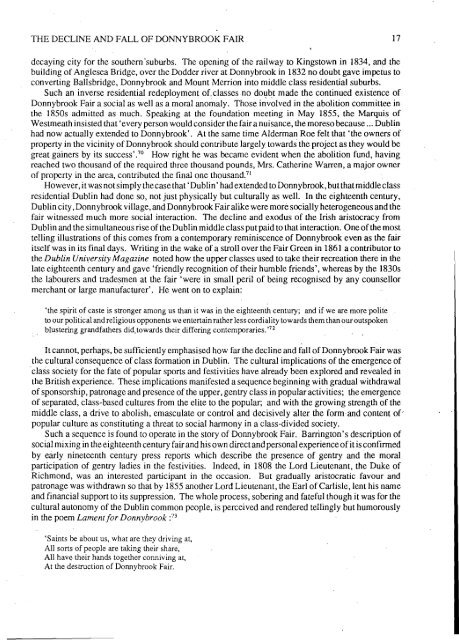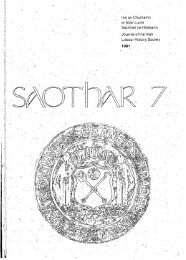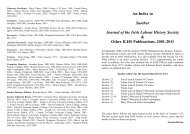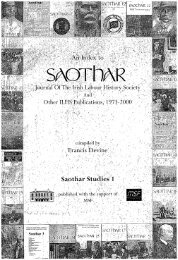16 SAOTHAR 13'an entire revolution in the nationallrish character (which) must have extended to all their sport and placesof amusement, and Donnybrook Fair, of course, has had its full share in the metamorphosis. '65Around the same period Philip Dixon Hardy noted of Dublin that 'the general character of theinhabitants, once gay and dissipated' had 'now become more serious and religious', and how their'ancient amusements of bull-baiting, hurling, cudgel-playing and wrestling are almost wholly laidaside'.66 Religious revival was clearly an important element in the moral transformation, but it is notthe entire story. Donnybrook Fair declined and fell just as much because of altered social relations asfrom police attention and religious crusading. The potency of the religious reform was that it coincidedwith the emerging value system of the rising Dublin middle classes. It was not just Protestant religionor Catholic religion that led to Donnybrook's fall, but middle class religion: a religion where time wasat a premium and popular pleasure at a discount.In this connexion it is quite clear from the comments of visitors like the Halls around 1840, of thepress in the mid 1840s and 1850s, and from the private comments of Wood lock in his diary in the mid1850s, that the wilder physical·and moral excesses of eighteenth century Donnybrook Fair no longerheld true and that the mid-nineteenth century festival was, by comparison, a tame and even soberoccasion. Yet it was precisely in this tamer and 'spiritless' form that the more intense exception wastaken to it, the greater indignation felt towards it, and the final assault of church, state and societylaunched against it. This is a sure indication of the extent to which social and moral sensitivity had nowdeveloped. Barrington's 'entire revolution' was well on its way by the 1830s to 1850s.Arising from this one cannot miss the impatience of Police Commissioners with 'idlers' and cornerboys, and their constant, disparaging references to the lower classes, nor pass over the significance ofCardinal Cullen's impatience with the loss of time which holding the fair entailed. One is confrontedwith the abolition committee's anxiety for the welfare of servants who had a seemingly incomprehensiblewish to attend the fair. It is clearly appropriate at this point to note that there is nothing peculiarto Dublin or to Irish history here and that priests and police played roles here not as prime causes so muchas agents, and by no means as sole agents at that. Much of Western Europe experienced the rise andtriumph of the new value system created by new social relations during this period. In this system hardwork, sobriety, privacy, individualism and hostility to time-wasting recreations were all preached andpractised as virtues. Rough sports and popular pastimes of the common people came to be frownedupon, despised and socially outlawed. In Britain particularly, scholarship has shed light on theprocesses at work 67 and there is surely significance that Donnybrook Fair was 'abolished' in the sameyear as the celebrated S1. Bartholomew's Fair in London.68The whole phenomenon is ultimately linked to the privatisation oflife and feeling and to the processof disciplining conduct bound up with the spread of capitalism and individualism in town and countryalike and which posed such a felt threat to political and social stability; Economic modernisation, evenin unfortunate Dublin of the mid nineteenth century, entailed a growing uniformity or pressure foruniformity of culture and conduct, at the same time as a heightening of class differences andseparateness. For Donnybrook itself, even Dublin itself, we have not yet got the detailed history thatcan nail down this process of class formation and its cultural consequences precisely. Nevertheless,it is clear enough that as the century wore on Donnybrook and its neighbourhood became much morea middle class suburb and much less a socially mixed but predominantly working class community.In the first half of the century, especially in the wake of Dublin's economic dislocation in the period1815-1840, there was undoubtedly a serious loss of working class employment in the general areabetween Donnybrook and Ringsend-Irishtown. The linen and printed textile mills of the Ballsbridgedistrict collapsed in the 1820s and 1830s in the face of English competition. Duffy's calico works atBallsbridge, for example, which employed some 500 people, went out of business at this time 69 andit is likely that the general area saw an exodus of working people to the city or the boats, in search ofwork. At the same time an opposite social migration occurred as middle class Dubliners deserted the
<strong>THE</strong> DECLINE AND FALL <strong>OF</strong> DONNYBROOK FAIR 17decaying city for the southern ·suburbs. The opening of the railway to Kingstown in 1834, and thebuilding of Anglesea Bridge, over the Dodder river at Donnybrook in 1832 no doubt gave impetus toconverting Ballsbridge, Donnybrook and Mount Merrion into middle class residential suburbs.Such an inverse residential redeployment of classes no dOl}bt made the continued existence ofDonnybrook Fair a social as well as a moral anomaly. Those involved in the abolition committee inthe 1850s admitted as much. Speaking at the foundation meeting in May 1855, the Marquis ofWestmeath insisted that' every person would consider the fair a nuisance, the moreso because .., Dublinhad now actually extended to Donnybrook'. At the same time Alderman Roe felt that 'the owners ofproperty in the vicinity of Donnybrook should contribute largely towards the project as they would begreat gainers by its success' .70 How right he was became evident when the abolition fund, havingreached two thousand of the required three thousand pounds, Mrs. Catherine Warren, a major ownerof property in the area, contributed the final one thousand. 7 !However, it was not simply the case that 'Dublin' had extended to Donnybrook, but that middle classresidential Dublin had done so, not just physically but culturally as well. In the eighteenth century,Dublin city, Donnybrook village, and Donnybrook Fair alike were more socially heterogeneous and thefair witnessed much more social interaction. The decline and exodus of the Irish aristocracy fromDublin and the simultaneous rise of the Dublin middle class put paid to that interaction. One of the mosttelling illustrations of this comes from a contemporary reminiscence of Donnybrook even as the fairitself was in its final days. Writing in the wake of a stroll over the Fair Green in 1861 a contributor tothe Dublin U nilier sity Magazine noted how the upper classes used to take their recreation there in thelate eighteenth century and gave 'friendly recognition of their humble friends', whereas by the 1830sthe labourers and tradesmen at the fair 'were in small peril of being recognised by any counsellormerchant or large manufacturer'. He went on to explain:'the spirit of caste is stronger among us than it was in the eighteenth century; and if we are more politeto our political and religious opponents we entertain rather less cordiality towards them than our outspokenblustering grandfathers did.towards their differing contemporaries.'72It cannot, perhaps, be sufficiently emphasised how far the decline and fall of Donnybrook Fair wasthe cultural consequence of class formation in Dublin. The cultural implications of the emergence ofclass society for the fate of popular sports and festivities have already been explored and revealed inthe British experience. These implications manifested a sequence beginning with gradual withdrawalof sponsorship, patronage and presence of the upper, gentry class in popular activities; the emergenceof separated, class-based cultures from the elite to the popular; and with the growing strength of themiddle class, a drive to abolish, emasculate or control and decisively alter the form and content of'popular culture as constituting a threat to social harmony in a class-divided society.Such a sequence is found to operate in the story of Donnybrook Fair. Barrington' s description ofsocial mixing in the eighteenth century fair and his own direct and personal experience of it is confirmedby early nineteenth century press reports which describe the presence of gentry and the moralparticipation of gentry ladies in the festivities. Indeed, in 1808 the Lord Lieutenant, the Duke ofRichmond, was an interested participant in the occasion. But gradually aristocratic favour andpatronage was withdrawn so that by 1855 another Lord Lieutenant, the Earl of Carlisle, lent his nameand financial support to its suppression. The whole process, sobering and fateful though it was for thecultural autonomy of the Dublin common people, is perceived and rendered tellingly but humorouslyin the poem Lament for Donnybrook: 73'Saints be about us, what are they driving at,All sorts of people are taking their share,All have their hands together conniving at,At the destruction of Donnybrook Fair.
- Page 1 and 2: JOURNAL OF THE IRISH LABOUR HISTORY
- Page 3 and 4: ContentsPageEditorial: Labour Histo
- Page 5 and 6: EDITORIAL 3freedom to participate i
- Page 7 and 8: CorrespondenceThe Irish Labour Part
- Page 9 and 10: ; ~ ; ,The Decline and Fall of Donn
- Page 11 and 12: THE DECLINE AND FALL OF DONNYBROOK
- Page 13 and 14: THE DECLINE AND FALL OF DONNYBROOK
- Page 15 and 16: ·' THE DECLINE AND FALL OF DONNYBR
- Page 17: THE DECLINE AND FALL OF DONNYBROOK
- Page 21 and 22: THE DECLINE AND FALL OF DONNYBROOK
- Page 23 and 24: THE DECLINE AND FALL OF DONNYBROOK
- Page 25 and 26: ,'-,;-''''.A PASSAGE TO BRITAIN 23C
- Page 27 and 28: A PASSAGE TO BRITAIN 25only in the
- Page 29 and 30: A PASSAGE TO BRITAIN 27clothing._De
- Page 31 and 32: A PASSAGE TO BRITAIN 29established
- Page 33 and 34: ;:-.",.- .. .", ...... '.:. '
- Page 35 and 36: LOUIE BENNETI 33feminist movement w
- Page 37 and 38: :... ~: ."
- Page 39 and 40: -.- '.LOUlE BENNETT 37While there i
- Page 41 and 42: LOUIE ~ENNEIT 39Xl's encyclical Qua
- Page 43 and 44: LOUIE BENNEIT 41Bennett's own relat
- Page 45 and 46: LODIE BENNETT 43109; IWWU resolutio
- Page 47 and 48: Essays in ReviewCosherers, Wanderer
- Page 49 and 50: ••• .".'. >. '~"ESSA YS IN RE
- Page 51 and 52: ESSAYS IN REVIEW 49ConnolIy:Myth an
- Page 53 and 54: ESSAYS IN ~EVIEW 51tion' in the Int
- Page 55 and 56: ESSAYS IN REVIEW53International:'I
- Page 57 and 58: REVIEWScontroversy is real history.
- Page 59 and 60: REVIEWSJoe Monks was among the earl
- Page 61 and 62: REVIEWSnolly-Column Song','Proudly
- Page 63 and 64: REVIEWSresulting from the arrival o
- Page 65 and 66: REVIEWS,63the book by means of an a
- Page 67 and 68: REVIEWSlogue, it is hardly surprisi
- Page 69 and 70:
The Team For All Workers ...CULIAIB
- Page 71 and 72:
ESSAYS 69mission and moral refonn.l
- Page 73 and 74:
.. ...... ~.~ -~ .'- '.ESSAYS. 71fr
- Page 75 and 76:
ESSAYS 73claimed authority but whic
- Page 77 and 78:
ESSAYS 75provided the basis for soc
- Page 79 and 80:
ESSAYS 779. For comparisons see E.T
- Page 81 and 82:
ESSAYS 7952. Annals of Christ Churc
- Page 83 and 84:
ESSAYS' 81Fianna Fail and the Worki
- Page 85 and 86:
ESSAYS 83Eireann in 1925 visibly di
- Page 87 and 88:
ESSAYS 85recognition of the impract
- Page 89 and 90:
ESSAYS 871970, it created the condi
- Page 91 and 92:
ESSAYS89The Irish Immigrants' Contr
- Page 93 and 94:
ESSAYS" 91Although anti -Catholic p
- Page 95 and 96:
ESSAYS 93McCowie played a key role
- Page 97 and 98:
:. -,,'.' ',. .~.,:.ESSAYS 95Althou
- Page 99 and 100:
ESSAYS 97young girl of their own ba
- Page 101 and 102:
SourcesIrish Labour History Society
- Page 103 and 104:
SOURCES 101INovember, 1971 to no. 1
- Page 105 and 106:
SOURCES 103would claim credit for t
- Page 107 and 108:
SOURCES105Sources for Irish Labour
- Page 109 and 110:
SOURCES 107NorthWest Archives and L
- Page 111 and 112:
SOURCES 109In 1966 the Finnish gove
- Page 113 and 114:
TURNINGANEWLEAFThe CPSSUis the larg
- Page 115 and 116:
REMINISCENCE 113us due to my politi
- Page 117 and 118:
REMINISCENCE 115when Jim was presen
- Page 119 and 120:
REMINISCENCE 117of Dail Eireann. 17
- Page 121 and 122:
REMINISCENCE 119NotesThe above arti
- Page 123 and 124:
DOCUMENT STUDY 121James Connolly in
- Page 125 and 126:
DOCUMENT STUDY123SOCIAL DEMOCRATIC
- Page 127 and 128:
DOCUMENT STUDY 125proletariat of th
- Page 129 and 130:
DOCUMENT STUDY 127the support of Je
- Page 131 and 132:
DOCUMENT STUDY 12926. The Workers'
- Page 133 and 134:
131BibliographyA Bibliography of Ir
- Page 135 and 136:
BIBLIOGRAPHY 133Compton, P.A. Demog
- Page 137 and 138:
BIBLIOGRAPHY 135Levine, I. and Madd
- Page 139 and 140:
BIBLIOGRAPHY 137Turner, M. 'Towards
- Page 141 and 142:
BIBLIOGRAPHY 1394. Land and Agricul
- Page 143 and 144:
BIBLIOGRAPHY 141Clogher Record12 (2
- Page 145 and 146:
BIBLIOGRAPHY 143Political Research
- Page 147 and 148:
BIBLIOGRAPHY 145Pres, 1987.O'Brien,
- Page 149 and 150:
147Notes on Contributorsf onathanBe
- Page 151 and 152:
1901: Ireland's first general union
- Page 153 and 154:
ELECTRICAL TRADES UNION .Establishe





